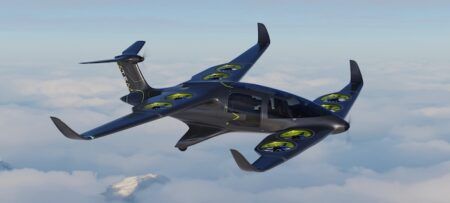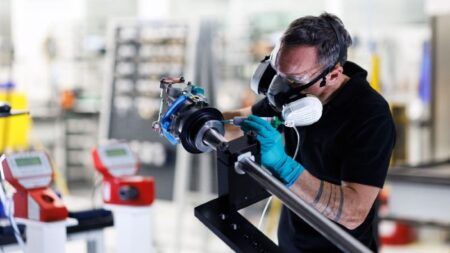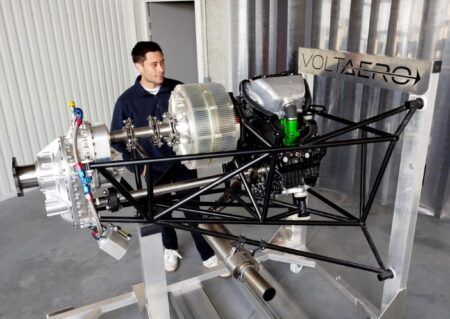DARPA has completed flight-testing of a subscale version of a novel aircraft design as part of its vertical take-off and landing (VTOL) X-Plane program, and is proceeding with work to develop a full-scale version of the groundbreaking airplane. Developed and fabricated by Aurora Flight Sciences, the revolutionary aircraft includes 24 electric ducted fans – 18 distributed within the main wings and six in the canard surfaces, with the wings and canards tilting upward for vertical flight and rotating to a horizontal position for wing-borne flight. The successful tests suggest there is a time in the not-so-distant future when VTOL aircraft could fly much faster and farther than any existing hover-capable craft, and take off and land almost anywhere.
Subscale testing began on the VTOL program in March of 2016 and the first phase of testing ended after six flights with demonstration of auto take-off, sustained hover, directional and translational control (including lateral and rearward flight), waypoint navigation, and auto landing. Later, the aircraft wing and canard tilt mechanisms, tilt schedules, and wing-borne flight controls were enabled for testing. Four of the test flights featured an expanded flight envelope in which the vehicle experimented with increases in air speed until the wing generated most of the lift.
“The VTOL demonstrator was designed specifically to test the aerodynamic design of the aircraft, validate flight dynamics, and develop the flight and mission-systems controls for application to the full-scale vehicle,” said Ashish Bagai, DARPA program manager. “The aircraft exhibited exceptional flight characteristics, with no loss in altitude even as it transitioned from vertical to horizontal flight. It also demonstrated aerodynamic effectiveness of the distributed propulsive system.”
The subscale aircraft flight and mission control architectures will, for the most part, be carried over into the full-scale VTOL aircraft, but with a few additions and improvements. According to Bagai, the full-scale aircraft will incorporate a triple-redundant flight control system instead of a single system. A hybrid turboshaft engine driving electric generators to power the fan units, versus the demonstrator’s batteries, will power the full-scale aircraft. Finally, the full-scale aircraft fan units will be synchronized to the generators and turn at a constant RPM, but incorporate variable pitch, whereas the demonstrator’s fans are speed controlled.
In addition to serving as a flight controls systems developmental aircraft, the VTOL subscale demonstrator advanced a number of technologies such as 3D-printed plastics for flight structures and aerodynamic surfaces as well as embedded distributed electric propulsion. The subscale demonstrator also improved methods to develop the aerodynamic databases upon which the air-vehicle control system is modeled, and provided lessons for the flight control system.
With the subscale test flights completed, the aircraft will be preserved for possible additional tests in the future. Meanwhile, all on-going program efforts will focus on the development of the full-scale VTOL X-Plane aircraft, which now bears the official designation of XV-24A.
The XV-24A will weigh 12,000 lb compared with the demonstrator’s 322 lb, and will aim to demonstrate specific performance objectives stipulated by DARPA: flight speeds in excess of 300kts, full hover and vertical flight capabilities, and – relative to helicopters – a 25% improvement in hovering efficiency and 50% reduction in system drag losses during cruise.
“These are ambitious performance parameters,” Bagai said, “which we believe will push current technologies to the max and enable a new generation of vertical flight operational capabilities.”
Click here to see a video of the DARPA VTOL X-Plane testing.
April 6, 2017




